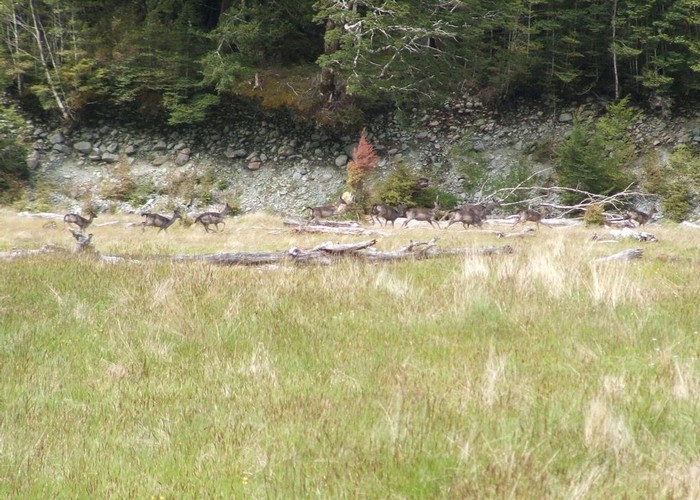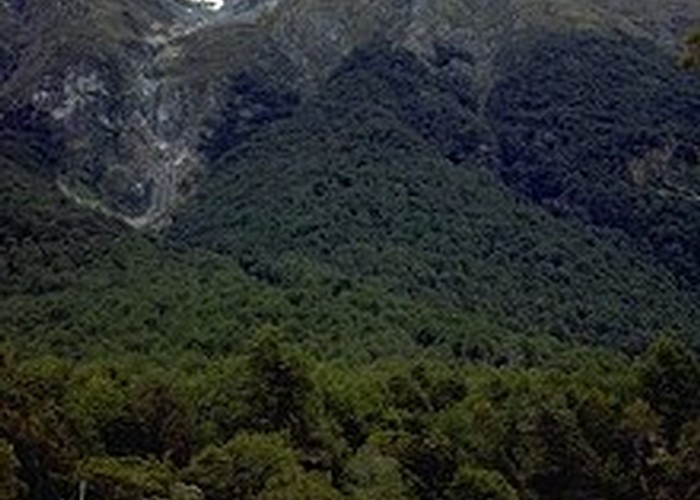The Greenstone / Caples circuit is a common 4-5 day choice, returning you to your starting point either on Lake Wakatipu or the Milford Road. Walkers from the Routeburn often turn off at Howden Hut and return by one of these two valleys to the Wakatipu region.

The misconception is widespread that the Caples Track is a shorter route to Lake Wakatipu than the Greenstone. This is incorrect, and furthermore, the crossing of McKellar Saddle is significantly more difficult than anything on the Greenstone Track (and, for that matter, anything on the Routeburn Track). The briefest glance at the Trackmap listed above will verify this.
Camping is prohibited between Upper Caples Hut and Lake McKellar due to the fragile ecosystem. There is, otherwise, good camping along the valley. It is however only permitted at the bush edge, not on the grassy flats, which are leasehold farmland (just don't camp next to the cows).
If you intend to drink the water out of the Caples River, you should take precautions against Giardia.
Access
The track end at the confluence of the Greenstone and Caples Rivers is a brief walk from a car park at the Greenstone River mouth on Lake Wakatipu. A rough 4WD road leads south from Kinloch, and public transport is available from Queenstown. The Lake McKellar track end is less than 2 hr walk via the last of the Routeburn Track to the Divide Shelter on the Milford Road. On a clear day allow time for a side trip onto Key Summit. Buses run regularly along SH94 between Milford Sound and Te Anau. Check transport details in Te Anau or Queenstown before you set out.
Greenstone / Caples Confluence-Mid Caples Hut: 2-2½ hr, easy
From the junction of the tracks and the confluence of the rivers the Caples Track follows river flats, keeping for the most part to the bush. Cattle graze in these grass flats, which are leased to local farms. Pairs of Paradise shelducks are persistent, noisy company. They have a habit of synchronising their individual monosyllabic calls, creating a bizarre stereophonic effect. Across the river, the poplars around the Birchdale Homestead are markers that draw slowly nearer. (New Zealand "beeches" were once known as "birches.") A shack and old fences can be seen, but the homestead itself seems to be only visible once you have walked well past it. Nearing the first hut, the track crosses an open space before entering forest and climbing briefly onto an old terrace. Here the river is compressed into a very deep and narrow gorge spanned by a small bridge. The hut perches on the opposite bank.
Mid Caples Hut-Upper Caples Hut: 1½-2½ hr, easy
Wandering along a grassy terrace on the true right bank, the track drops occasionally onto the stony river-bank. Here, and particularly in the creeks that cross the track, the stones are notable. They are a colourful mixture of red and green sandstones containing, in several different combinations, lumps of red or green mudstone. These colours reflect the presence of iron in the minerals chlorite (green) and hematite (red). These stones are visible from the Upper Caples Hut out to the lake. They are also visible downstream from the Mid Greenstone Hut, although there they seem to have a duller character.
Forest closes in occasionally, pinching off a series of river flats. Black fallow deer are common on the flats. As the flats become smaller and the valley narrower the track stays in bush, soon reaching the next hut in the small clearing of Tent Flat.
Riflemen, robins and brown creepers inhabit the forest around the hut. Corybas orchids may be found in the boggier ground. Deer sometimes lurk outside the hut in the evening and early morning.
Upper Caples Hut-McKellar Saddle: 3 hr, easy-moderate
Entering mossy beech forest the track begins the climb toward McKellar Saddle. Watch for the brightly coloured yellowheads on the track and listen for the chatter of yellow-crowned parakeets in the canopy. The distribution of yellowheads is now severely limited and they are a memorable, although fleeting, sight. Parakeets are commonly heard, but they are not seen so easily, and they are shy of people. Often these two species are found in close proximity. In warmer months listen also for the calls of the shining cuckoo and the long-tailed cuckoo. The first sings a series of watery rising notes followed by one or two falling notes, reminiscent of some introduced species. The second produces a loud, insect-like, rising screech.
The track flattens off and resumes climbing several times before clambering with difficulty along the bouldery river-bank and crossing what remains of the Caples River. From here it climbs vigorously into the subalpine zone and onto McKellar Saddle. The ground is boggy with small tarns and a length of boardwalk to protect the plant communities. At the point where the track begins the descent into the Greenstone Valley you can observe a ridge of the Livingstone Mountains opposite, beyond which lies the Milford Road. Lake McKellar skulks below you on the valley floor. The Darran Mountains are visible to the right.
McKellar Saddle-Lake McKellar Junction: 1-2 hr, moderate
The 300m drop into the Greenstone Valley is steep, rocky and slow. The track then moves up-valley past the head of the lake, on a poorly defined and equally awkward trail, finally turning onto the boggy flats and crossing to the western side of the valley where the Greenstone Track leads north and south. A sign indicates Howden Hut to the north and McKellar Hut to the south. From here you can exit onto the Milford Road at the Divide or you can turn down the Greenstone Valley to loop back to the beginning of the Caples Track.

